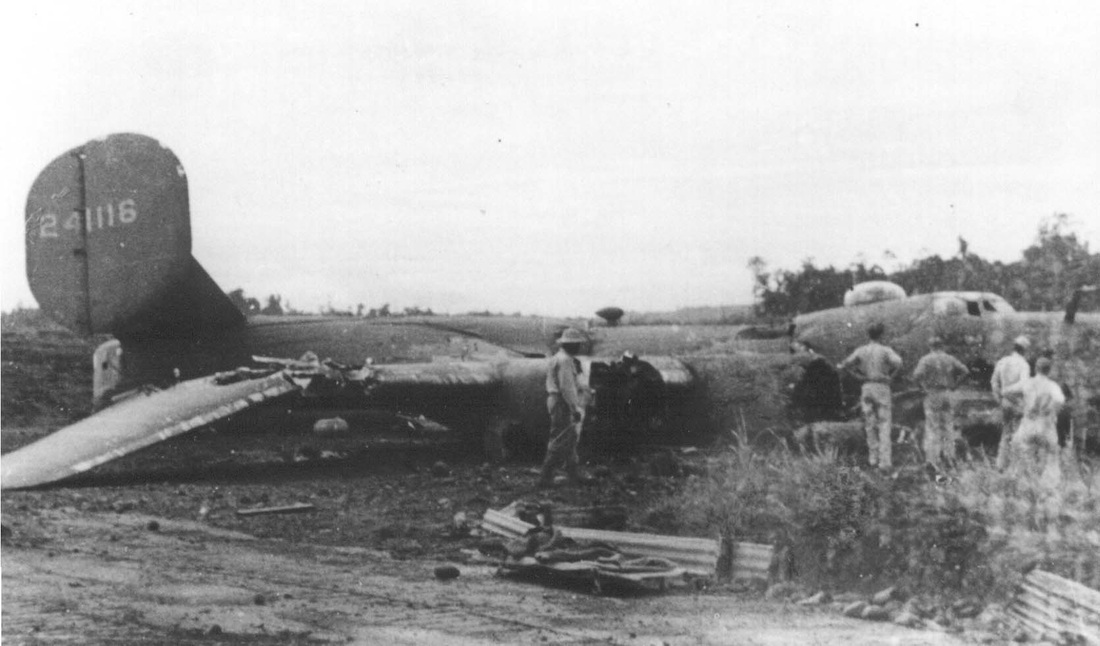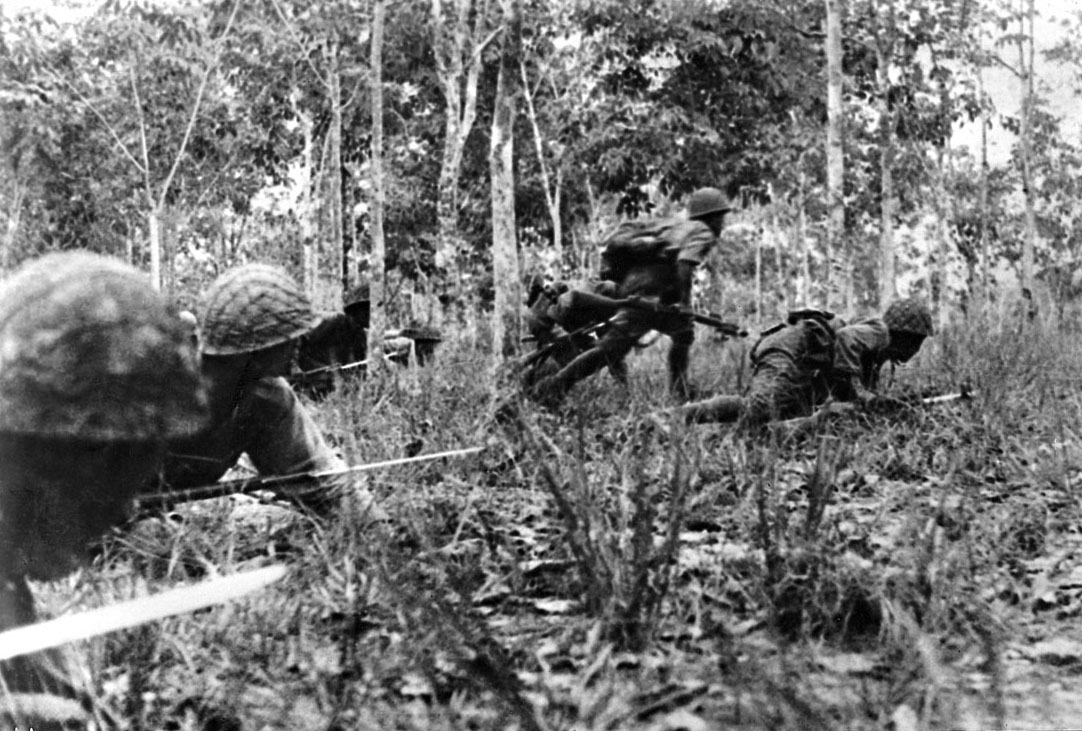Admiralty Islands
The Japanese batteries at the entrance to Seeadler Bay are bombarded once again by Adm Victor Crutchley's 3 cruisers and 4 destroyers. Elements of the 5th Cavalry capture Papitalai and the eastern part of Seeadler Harbor in Los Negros Island. The 5th Cavalry occupies Porlaka. B-25 aircraft are able to make emergency landings on Momote airfield.
[Air Operations, Bismarcks
- RAAF bombers and 80th Fighter Squadron P-38s attack Talasea in support of US Marine Corps ground operations against the base.
- AirSols fighters pass through Nissan airfield in the Green Islands as they attack Kavieng for the first time.
Air Operations, Carolines
VII Bomber Command B-24s attack Kusaie Island.
[Air Operations, CBI
BURMA- 2 490th Medium Bomb Squadron B-25s attack Japanese Army ground forces near Shaduzup. 1 B-25 attacks a bridge and barges near Shwebo. More than 20 10th Air Force P-51s and A-36s attack targets of opportunity while sweeping the area between Walawbum and Shaduzup.
Air Operations, Europe
Allied bombers attack the marshalling yards in Florence and Rome.
RAF BOMBER COMMANDEvening Ops:
- 304 aircraft are sent to Le Mans. Included in this total are 242 Halifaxes, 56 Lancaster and 6 Mosquitos of Nos. 3, 4, 6 and 8 Groups.
- The target is covered in cloud but heavy damage is believed to have been caused to the railway yards where about 300 bombs fell. 250 railway wagons are destroyed, many railway lines are cut, a turntable is put out of action and 6 locomotives damaged.
- There are no losses.
- 15 Mosquitos are sent to 4 German targets, there are 4 RCM sorties, 1 Serrate patrolm and 6 OTU sorties, and 51 aircraft are involved in Resistance operations.
- There are no losses.
FRANCE:
- A total of 112 IX Bomber Command B-26s and 18 A-20s attack military installations near Creil-sur-Mer and Greny, V-weapons sites along the Channel coast, and various targets of opportunity. 150 other B-26s dispatched against a marshalling yard at Creil are recalled due to bad weather.
ITALY:
- 12th Air Force B-25s attack Rome's Ostiense marshalling yards.
- 12th Air Forces B-26s attack a marshalling yard at Littoria.
- XII Air Support Command A-20s attack a railroad station.
- XII Air Support Command A-36s attack a railroad station near Civitavecchia, gun emplacements around the Littoria Airdrome, communications targets, and a train.
FRANCE:
- 15th Air Force B-17s attack the Toulon naval base.
- 15th Air Force B-24s attack a defended town, marshalling yards at four locations, and the Fabrica di Roma, Orvieto, and Viterbo Airdromes.
Air Operations, New Guinea
- V Bomber Command B-24s and B-24s attack the airfield at Bioram and Japanese Army ground troops on Los Negros Island. Only 5 of 17 B-25s assigned to attack islands in Seeadler Harbor are able to complete their mission in the face of bad weather.
- A damaged V Bomber Command B-25 lands at the Momote airfield on Los Negros, which is declared operational during the day.
CBI
BURMAIn the NCAC area, Merrill decides to withdraw the GALAHAD force to the south to block the Kamaing Road since Chinese troops are now in the Walawbum area. The 113th Regiment, Chinese 38th Division, its rear and flank protected by the 112th, closes in on the Walawbum area and re-establishes the roadblock vacated by the GALAHAD force. The CO of the 1st Provisional Tank Group, after unsuccessfully attempting to persuade the 113th Regiment to join in a frontal attack on Walawbum, finds the 64th Regiment, Chinese 22nd Division, agreeable to the suggestion. They move south together and block the Kamaing Road near Walawbum. Two roadblocks are established--one and two miles west of the Nambyu Stream. Tank forces intercept enemy forces on the march and disperse them.
About 2,000 Japanese are surrounded in the Hukawng Valley.
In Operation U-GO the 33rd Division of Lt-Gen Renya Mutaguchi's 15th Army launches a major offensive across the Chindwin River. The goal of the operation is to spoil any Allied offensive moves in central Burma by crossing into India, pushing Allied forces out of Burma in the process, cutting the Assam-Burma railway used for supplying Stilwell's Myitkyina offensive, and also occupying Imphal and Kohima and the flat territory between. The first part of the offensive involves the Japanese 33rd Division advancing out and cutting the Tiddim-Imphal Road, a major Allied supply route to Imphal, and trapping the 17th Indian Division based between Tiddim and Tongzang.
[Diplomatic Relations
Moscow says it considers the Curzon line unacceptable as the postwar border between Russia and Poland, holding that the frontier should be farther west.
[Eastern Front
SOUTHERN SECTORThe 1st Ukrainian Front advances rapidly. The 60th, 1st Guards and 3rd Guards Tank Armies approach Tarnopol, Chernyi and Ostrov. The 38th Army advances upon Starokonstantinovka. Hitler orders Tarnopol held to the last man, even if encircled.
[Germany, Home Front
Members of the Nazi organization for women are making house-to-house calls to recruit females between the ages of 17 and 45 to work 'in the service of the community'. This is to bolster Germany's depleted labor force.
[New Britain
The Japanese defend Volupai plantation, especially the trails leading out, as they are the main routes of escape to Rabaul for the Japanese. The 2nd Battalion, 5th Marines, attacks and pushes the enemy back along the trails.
[Solomons
The Japanese have at last assembled large forces around the US beachhead on Bougainville and are preparing a major attack. On the Green Islands the Allied forces have now completed the construction of an airfield.
[United States, Planning
SWPA headquarters notifies Alamo Force to prepare plans to seize Aitape and Hollandia. Aitape is 90 miles west-northwest of Wewak and has an airfield. Hollandia is a major Japanese base located on the coast of north-central New Guinea. Gen MacArthur is reading the Japanese military codes provided by Ultra. He realizes that Hollandia has few defenses against amphibious attack and the Japanese are anticipating an attack on Madang. In defending against the expected attack on Madang, the Japanese are moving fighter aircraft into Hollandia and preparing tto defend Hansa Bay and Wewak. MacArthru plans to bypass these defenses completely and attack the Japanese where they least expect it.
[Images from March 7, 1944
|
|
|
|



